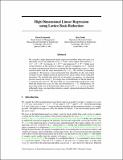High dimensional linear regression using lattice basis reduction
Author(s)
Gamarnik, David; Zadik, Ilias
DownloadPublished version (698.0Kb)
Publisher Policy
Publisher Policy
Article is made available in accordance with the publisher's policy and may be subject to US copyright law. Please refer to the publisher's site for terms of use.
Terms of use
Metadata
Show full item recordAbstract
© 2018 Curran Associates Inc.All rights reserved. We consider a high dimensional linear regression problem where the goal is to efficiently recover an unknown vector β∗ from n noisy linear observations Y = Xβ∗ + W ∈ Rn, for known X ∈ Rn×p and unknown W ∈ Rn. Unlike most of the literature on this model we make no sparsity assumption on β∗. Instead we adopt a regularization based on assuming that the underlying vectors β∗ have rational entries with the same denominator Q ∈ Z>0. We call this Q-rationality assumption. We propose a new polynomial-time algorithm for this task which is based on the seminal Lenstra-Lenstra-Lovasz (LLL) lattice basis reduction algorithm. We establish that under the Q-rationality assumption, our algorithm recovers exactly the vector β∗ for a large class of distributions for the iid entries of X and non-zero noise W. We prove that it is successful under small noise, even when the learner has access to only one observation (n = 1). Furthermore, we prove that in the case of the Gaussian white noise for W, n = o(p/log p) and Q sufficiently large, our algorithm tolerates a nearly optimal information-theoretic level of the noise.
Date issued
2018-12Department
Sloan School of Management; Massachusetts Institute of Technology. Operations Research CenterJournal
Advances in Neural Information Processing Systems
Citation
2018. "High dimensional linear regression using lattice basis reduction." Advances in Neural Information Processing Systems, 2018-December.
Version: Final published version